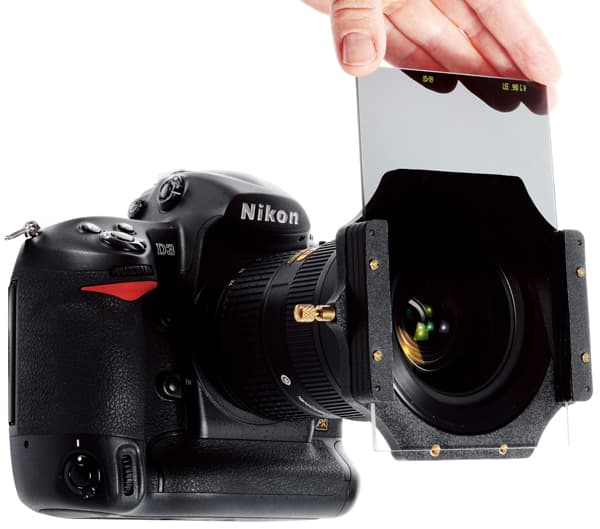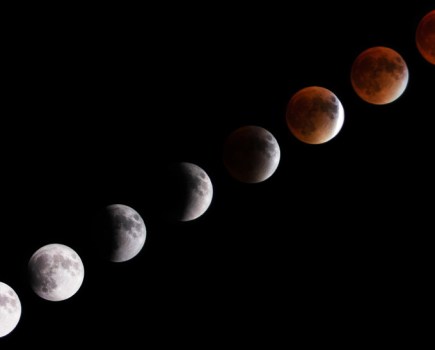Technology Explained: ND Grad Filters

The highlight warning on most DSLR cameras often makes the biggest problem with landscape photography obvious. That annoying flashing of the sky in the image on the LCD screen means that all its detail has been lost and, although the land beneath may be perfectly exposed, the bright clouds above have burned out.
Fortunately, the digital photographer has several methods available to overcome this problem. The most obvious is to reduce the exposure until the sky detail is visible and then brighten the underexposed areas on the computer. While this can be successful in some cases, it can be tricky to get a natural result and it brings out noise in the shadows.
An alternative approach is to take two or three shots with different exposures and then blend them to create a subtle high dynamic range (HDR) image. Though some HDR fans like to create flat, unnatural-looking pictures revealing detail that is invisible to the human eye, with a more delicate hand it is possible to produce a final image that resembles the original scene as we see it. However, problems arise when there is movement in the scene – swaying trees or grass, for example – as the merged images cannot exactly match-up.
Although these digital solutions can work, it is often better to use a method that has served photographers for decades and fit a graduated neutral density (ND grad) filter on the lens. With the dark part of the filter covering the bright areas of the scene, it is possible to set an exposure that results in an image without any burned-out areas, and with detail in both the sky and the land. For the enthusiast photographer who spends hours at work in front of a computer, this method has the added benefit of providing a solution that can be applied out in the fresh air, rather than back at the monitor.
Part of the beauty of using ND grad filters is that they are available in a range of strengths, so the system can be adapted for different scenes with more or less contrast between the brightness of the sky and land. Also, unlike applying a digital graduated filter effect that merely places a uniform darkening tone over the areas without detail, ND grads enable the camera to record the highlight detail and bring out the subtle tonal variations.
There are many graduated neutral density filters available on the market and in this article I will explain the differences and how to use them, and test a selection to see which are best.
 ND grads
ND grads
A graduated neutral density filter, often called an ND grad, is simply a filter that is clear at one end and dark (or grey) at the other. Positioning the dark part of the filter so it covers the bright section of the scene in the viewfinder enables the photographer to set an exposure that retains all the detail. An ND grad filter is often used to balance the brightness of the sky with the land in a landscape. Importantly, the dark part of the filter should be neutral so that it doesn’t give the clouds a colour cast.
An ND grad shouldn’t be confused with a plain neutral density filter, which doesn’t have a graduation and is used to reduced the amount of light entering the camera across the whole image frame. This enables a longer shutter speed or wider aperture than the bright conditions would normally allow.
Shapes and sizes
One of the most important aspects of using an ND grad is the position of the transition (or graduation) from clear to dark, so rectangular slot-in filters are the most popular type. These allow the transition to be positioned exactly where it is needed. However, it is still possible to get circular ND grads in a variety of diameters to suit different lenses and cameras. Though the transition usually cuts across the middle of the circle, the Bedfordshire based company SRB-Griturn offers a filter-cutting service that allows the transition to be positioned anywhere within the circle.
Although it is possible to find glass filters, most ND grads today are made from a form of resin or optical plastic. This is lighter and more affordable than glass and is more likely to survive a drop that would shatter a glass filter. The downside is that resin is more prone to scratching, so the filters need to be stored with care.
Naturally, larger filters tend to be more expensive than their smaller counterparts, but having a bigger rectangular grad affords more flexibility with the positioning of the colour or density transition.
Density
Graduated neutral density filters come in different densities or strengths to enable more or less light to be cut from the covered portion of the scene. This makes it possible to balance the exposure across the image whatever the difference in brightness between the sky and the foreground of a landscape.
The density of the dark part of an ND grad varies in exposure value (EV) so the photographer knows that using a particular filter will cut out one (or more) EV of light. Most manufacturers produce a range of filters capable of cutting out one, two or three EV of light, but some, such as Lee Filters, produce grads with intermediate strengths for greater control of the exposure across the image frame.
Selecting the correct filter can be confusing as manufacturers sometimes give them different names, such as ND4 or 0.6 ND, to indicate a filter of the same density. The table below outlines the relationship between the optical density, filter factor and the number of EV that the dark part of the filter reduces the exposure by.
| Optical Density | Filter Factor | Light Transmitted | Exposure Reduction in EV |
| 0 | 1 | 100% | 0 |
| 0.3 | 2 | 50% | 1 |
| 0.45 | 2.5 | 37.5% | 1.5 |
| 0.6 | 4 | 25% | 2 |
| 0.75 | 7 | 18.75% | 2.5 |
| 0.9 | 8 | 12.5% | 3 |
| 1.2 | 16 | 6.25% | 4 |
Hard or soft?
After determining what density of filter is required, the next decision is whether it should have a hard or soft graduation. Hard graduation filters, which quickly change from clear to dark, are the most popular choice as they allow the density transition to be positioned on the horizon where the sky is often the brightest. However, these filters can be spotted easily on subjects that cross from the darker part of the image to the bright area. A tree, for example, may appear to get darker halfway up its trunk.
Soft graduation filters have a more subtle transition so it is harder to spot that a filter has been used. They are useful for images with subjects that cross between the dark and bright areas of a scene, perhaps darkening a bright puddle of water within a landscape. As soft grad filters are less obvious to the eye, they can be trickier to position correctly because it is harder to see their effect in the viewfinder.

How to use an ND grad
There are two ways to use a graduated neutral density filter. The first is to set the camera to manual exposure mode and, without the filter in place, set exposure values for the foreground. The image is then composed and the ND grad slipped into place. With SLRs it is usually possible to see the darkening effect in the viewfinder. With a slot-in filter, take time to push the filter up and down again until the transition falls exactly where it is needed – on the point that the light and dark areas of the scene meet. With a landscape this is usually at the horizon.
Modern metering systems lend themselves to a second, simpler method of using an ND grad. With the image composed in the viewfinder (or on the LCD), the filter is slid into place as before and the shot taken using the settings the camera has calculated to be correct for the scene as a whole. The histogram view will confirm whether all the highlight detail has been recorded. If the peak is towards the middle of the scale, a less dense filter can be used.
Filter selection
A 0.6 ND grad, which reduces the exposure of the brightest areas by two stops, is a good starting point and is generally sufficient for daytime use in sunny weather. However, a 1.2 ND grad, which reduces exposure by four stops, can be useful at sunset when shooting towards the sun. While multiple filters can be used to darken bright parts of the scene further, this increases the number of reflective surfaces in front of the lens, which increases the chances of introducing flare and reducing contrast.
The easiest way to check which density of filter is required is to set the camera to aperture priority mode at the aperture setting you wish to use. Then use the spot or partial metering option to take light readings from a midtone in the foreground and an area of middle-level brightness in the sky. The difference in exposure between these two readings gives the strength of the filter required to balance the exposure across the frame.
For example, if the foreground requires an exposure of 1/60sec at f/16, while the suggested reading for the sky is 1/250sec at f/16, giving a difference of two stops, a 0.6 ND grad should be just right. Alternatively, the camera’s histogram view can be used to check whether the ND grad has enabled all the sky detail to be retained. This is indicated by the trace just reaching the far right without a large peak at this end of the scale.
The test
There are two key things you want from a graduated neutral density filter. First, it should be neutral, so it doesn’t introduce any unwanted colour cast, and second, it should cut out the correct amount of light (in this case reducing the brightness by 104).
The following details the results from my test of 0.6 ND grad filters from six different manufacturers. I checked the filters’ neutrality by photographing a sheet of white paper in the sun (with a custom white balance setting) with and without the filters in place over the lens.
I then compared the colour of images taken with and without the filters using the Eyedropper tool in Adobe Photoshop CS3 to find the change in the red, green and blue (RGB) values.
The greater the difference between these values, the greater the colour shift. Even a small shift impacts upon the midtones and can be noticeable in a landscape.
|
|
Cokin P-series 84x100mm ND4 grad (Medium) £21.00Intro2020, Unit 1, Priors Way, Maidenhead, Berkshire SL6 2HP. Tel: 01628 674 411. Website www.intro2020.co.uk Cokin offers slot-in hard and soft ND grads in four sizes: A, P, Z-Pro and X-Pro, wit h the A-series being the smallest (67x67mm) and X-Pro the largest (100x150mm). One, two and three-stop grads are available in each size. Our tests reveal that the ND4 filter is a little less dense than we would expect and that it imparts a slight blue colour cast. Red: 107 Green: 109 Blue: 114 |
|
|
Formatt Hitech 100x150mm 0.6 ND grad (hard) £44.00Formatt Filters, Unit 23, Aberaman Park Industrial Estate, Aberaman, Aberdare, Mid Glamorgan CF44 6DA. Tel: 01685 870 979. Website: www.formatt.co.uk Formatt offers two sizes of filter: the Hitech 85 (84x110mm compatible with Cokin P-system) and Hitech 100 series (100x100mm or 100x150mm). Hard and soft ND grads are available. I found the 0.6 ND grad is quite dark, reducing brightness by 120 (in Photoshop) rather than the anticipated 104. There is also a noticeable blue cast. Red: 83 Green: 88 Blue: 93 |
|
|
Kood 100x125mm dark grey grad £23.00
Kood International offers ND grads with transitions described as halfway between a soft and a hard graduation in three sizes: two that are compatible with the Cokin A- and P-system, plus 100x125mm. I found the transition is very gradual and this filter is the least dense of all the filters tested here. There is also a slight green note to the images.
Red: 124 Green: 133 Blue: 131 |
|
|
Lee Filters 100x150mm 0.6 ND grad (hard) £52.00Lee Filters, Central Way, Walworth Industrial Estate, Andover, Hampshire SP10 5AN. Tel: 01264 366 245. Website: www.leefilters.com Lee Filters can provide hard or soft ND grads with densities of 0.3, 0.45, 0.6, 0.75, 0.9 and 1.2. Lee’s graduated filters measure 100x150mm, giving plenty of scope for positioning the gradation. I found the 0.6 ND filter reduces the exposure by a lit tle over 2EV and there is only a slight colour shift towards the blue part of the spectrum. Red: 94 Green: 95 Blue: 99 |
|
|
SRB-Griturn 85x110mm 0.6 ND grad (hard) £12.50SRB-Griturn Ltd, Unit 21D, Icknield Way Farm, Tring Road, Dunstable, Bedfordshire LU6 2JX. Tel: 01582 661 878. Website: www.srb-griturn.com SRB-Griturn’s slot-in filters are compatible with either the Cokin A- or P-system, and are available with hard or soft gradations in four densities: 0.3, 0.6, 0.9 and 1.2. I found the sharp transition of the hard grad easy to position and the 0.6 density reduces the brightness almost as it should, but there was a significant blue cast to the images. Red: 94 Green: 94 Blue: 103 |
|
|
Tiffen 4x4in 0.6 ND grad (soft) £205.00Tiffen Europe Ltd, Enterprise House, Weston Business Park, Weston on the Green, Oxford OX25 3SX. Tel: 01869 343 835. Website: www.tiffen.com Though it is mainly known for its round filters, Tiffen also produces glass rectangular filters in a variety of formats, and a glass Tiffen filter compatible with the Cokin P-system costs in the region of £127. I found the 4x4in 0.6 ND test sample to be the most neutral in this group. The brightness reduction is also only a little more than 104. Red: 112 Green: 112 Blue: 110 |





















